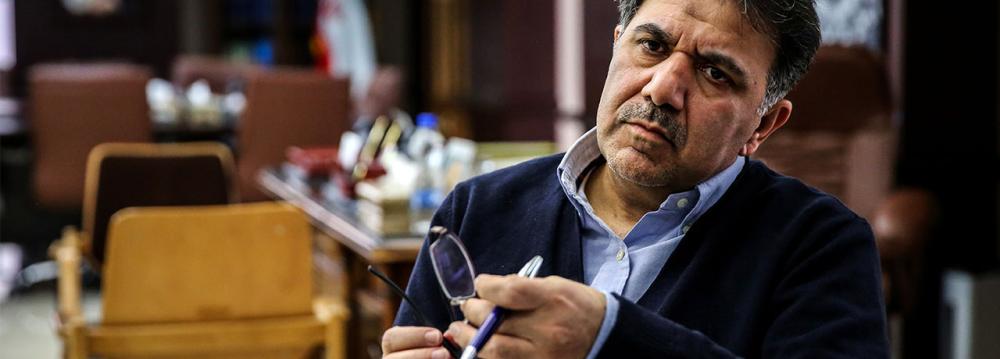President Hassan Rouhani submitted on Tuesday the list of his new Cabinet picks to the parliament for a vote of confidence.
Among the nominees, Minister of Roads and Urban Development Abbas Akhoundi, who has been leading the ministry over the past four years, is widely tipped to be reappointed.
As expected, ahead of the confidence vote, the minister has released his plans for the upcoming four years as follows:
Railroads
Akhoundi said he plans to develop Iran’s rail infrastructure and increase the length of main lines to 13,000 kilometers.
Iran has 3,500 kilometers of railroads under construction.
The minister earlier said the government would operate 1,800 kilometers of railroads by the end of the current Iranian year (March 20, 2018), of which more than 900 km pertain to double tracking.
The government has prioritized rail connections between five provincial capitals.
In May, a 267-km line between Tehran and Hamedan’s provincial capital came on stream. Four other provincial capitals have been planned to join Iran’s rail network by March 2018. These projects include Qazvin-Rasht, the so-called Gharb (West) project connecting the city of Arak in the central Markazi Province to Khosravi Border Crossing in the western Kermanshah Province bordering Iraq, Mahabad-Urmia and Mianeh-Bostanabad.
Track-laying for the railroad connecting Kermanshah to Iran’s national rail network was completed earlier this month. However, it will take a few months for the project to become fully operational.
Akhoundi also plans to finalize contacts to provide foreign financing for a few major projects, including construction of a high-speed train from Tehran to the central provincial capital of Isfahan and electrification of a railroad from the eastern city of Mashhad to the northern cities of Garmsar and Incheh Borun.
The former project is to be financed by China. Iran has signed a contract with China Railway Group Limited to implement this project. Although the contract was signed in 2015 with an estimated value of €1.8 billion, its scope and value are expected to expand.
Russia will extend €1.2 billion in finance for the Garmsar-Incheh Borun electrification project.
A similar project for the electrification of a 926-km Tehran-Mashhad railroad was recently finalized. China’s Exim Bank signed a contract to provide $1.5 billion in finance for the electrification of the line, which will be conducted by China National Machinery Import and Export Corporation and its Iranian partner MAPNA Group.
Roads
Akhoundi plans to increase the length of Iran’s freeways to 7,500 kilometers, in line with the target stipulated in the Sixth Five-Year Development Plan (2017-22).
There are 2,500 kilometers of freeways across the country.
The government has invested 30 trillion rials ($800 million) in the past two Iranian years (March 2015-17) for the construction of freeways. Some 2,000 kilometers of freeways in the form of 10 projects are currently under construction.
The 253-kilometer Tabriz-Marand-Bazargan freeway, launched early April, and the 225-kilometer Isfahan-Shiraz freeway are among the main freeway projects underway.
Another important project is a freeway connecting the capital Tehran to Chalous in Mazandaran Province. The mega project worth $2.2 billion consists of four sections spanning 121 km.
Rejuvenating the country’s road fleet is also among Akhoundi’s plans. He says he wants to reduce the age of Iran’s cargo fleet from 17.3 years to 15 years and the age of the bus fleet from 12.7 years to 12.5 years.
Air
Akhoundi says his ministry will increase the number of active passenger planes from the current 147 aircraft to 228 by 2022.
Most of the new air fleet will come as part of the orders Iranian airlines have placed with the world’s major planemakers after Tehran signed the landmark nuclear deal in 2015, including Iran Air’s orders of 100 jets from Airbus, 80 planes from Boeing and up to 40 turboprop planes from ATR. Iran Air has been delivered seven planes so far, including three from Airbus as well as seven from ATR.
Iran Aseman Airlines has also secured a deal with Boeing to purchase up to 60 jets.
Other Iranian airlines have either signed memoranda of understanding with Boeing and Airbus, or have been in talks with planemakers to renew their fleet.
Among his plans, the minister refers to development of Imam Khomeini International Airport and seven other Iranian airports through domestic and foreign investment.
He promised to breathe life into small airports by increasing the number of short-range planes.
The ministry is looking to transport 36 million passengers in domestic routes by 2022.
Ports
Akhoundi said the cargo handling capacity of Iranian ports will reach 263 million tons per year.
He noted that his ministry will provide incentives to increase the number of new shipping lines to and from Iran.
International shipping lines, including Mediterranean Shipping Company, Evergreen Line, CMA CGM and Maersk Line, resumed services to Iran after the removal of sanctions as part of the nuclear deal.
Major development projects have been underway in Iranian ports in the past years, including construction projects in the southeastern port of Chabahar, expansion of the southern Shahid Rajaee Port in Hormozgan Province as well as projects in northern ports of Amirabad and Anzali.
Housing, Urban Development
The minister is planning to carry out a “fundamental review of Iran’s urban design, development and management system” to create “urban discipline”.
His ministry will focus on raising the purchasing power of first-time home-buyers.
Rural residential units will be increased to 900,000.
The ministry will also be committed to conclude the protracted Mehr Housing Project, which was a plan proposed by the former administration.
The controversial Mehr Housing Project was launched by the administration of former president, Mahmoud Ahmadinejad, to provide low-income groups with cheap homes. The project has been in the works for nearly a decade. Although opposed to the project, Rouhani’s administration has vowed to see it through.


